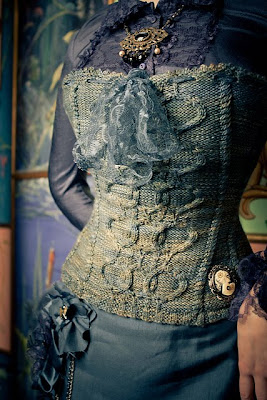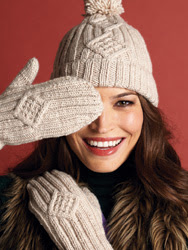Knit Simple has posted their
Winter 2012 Issue preview. Let's have a look at some of their offerings, shall we?
So... pom-poms. This sweater did really need an interesting collar to set off the very nice but generic rest of itself. I'm just not sure pom-poms were the way to go.
Very pretty rib and cable sweater.
I like this one, but I'll warn you, if you make this sweater just as the pattern directs, you're going to need a very long neck to be able to carry it off. Even the model isn't quite working it, and she has a longer than average neck.
Nice, but putting your hands in that pocket is going to look and feel awkward. If you know you're the hands-in-double-pocket type, make the sweater shorter.
As I've said a number of times on this blog, I am not a fan of the double-breasted style. It's not becoming on women who aren't tall, slender and small-breasted (i.e., not models), and it never looks good worn open. Occasionally there are exceptions, but this isn't one of them. Even the model looks frumpy in this one.
I don't care for this one, but it's a matter of personal preference rather than anything being objectively wrong with the pattern. The colour is analogous and it's working, but I find it kind of garish. Peruvian hats are very appealing in their own way, but they are bohemian in style (unless, of course, you actually
are Peruvian), and the Boho style is really only for young women. Older women who try to adopt the Boho look usually end up looking like bag ladies.
Cute little cap. The button's actually doing quite a bit for it, and setting it slightly apart from all the millions of cute little knitted caps out there.
Classic hat and mittens set.
This hat would make me feel, and no doubt look, exactly like
the Chicken Lady.
Very pretty scarf, but I'd put a fringe or some kind of finishing touch on the ends, which just look too blunt and unfinished the way they are.
Very pretty couple of afghans. Make either of these in a yarn and a colour you love, and you'll enjoy them for many years to come.
I'd have put about five buttons on this hooded vest, rather than only two. Those two buttons look too random, and unless there's some interior fastening that doesn't show here, the front of this sweater will pull open at the bustline every time the woman wearing it uses her arms.
This would be nice as costuming for some romantic movie, but it's wildly impractical for real life. It would get into everything, and you'd be constantly rearranging it.
This is not a bad capelet. It drapes well and the toggles aren't a bad touch. This is something you can just throw on for running errands.
This capelet and the next four designs are from a toggle-themed section in which
Knit Simple demonstrates that their designers don't really know how to use toggles in design. The question you have to ask yourself when deciding whether to put toggles on something you've made is, "Would buttons look better on this item?", and if the answer is "Yes," you should go with the buttons.
This isn't a bad sweater, but the toggles don't work at all with its colour scheme (the editors have compensated for that by putting a turtleneck underneath that did go with the toggles, but do you really want to be limited to having to choose a shirt that goes with the toggles on your cardigan?) and the two fronts of the cardigan don't meet in the front, which is probably supposed to be a design element but just makes a sweater look like it's too small.
Not a bad jacket, and the toggles are... neither adding nor detracting. Just beware that it's going to bulk you up when you wear it.
I think the designer of this thing was locked in a room with a sketchpad and a handful of these toggles and told she wouldn't be let out until she came up with a design that used them. Even the model looks frumpy and dumpy in the resulting disaster. Those tan-coloured lines at the raglan seams, the wrist, the waist and the sides of this sweater are probably meant to go with the toggles, but just end up looking senseless and ugly. It would have been a far better idea to replace the lines of tan with a line of cabling or some other intricate stitchwork, and to add some waist-shaping. Oh, and to replace the bloody toggles with buttons.

I keep an eye out for good uses of self-striping yarn, because so many designers don't seem to know what to do with it. This sweater really made me sit up and pay attention. The concept is really good: shaped striped front panels that flatter the figure and draw the eye upward, with the rest of the sweater kept fitted and clean and simple. The collar really works, and it's not even a kind of collar I'd normally care for. But I'm not sold on the toggles. They do work well with the colour scheme, but they compete somewhat with the design without really adding to it. Some other kind of fastener would have given this cardigan a better finishing touch, and I doubt this cardigan will look all that good when worn open.



I have to admit, the snowman hat and mittens made me smile. The other two patterns look a little over the top and a little less successful, perhaps partly because there are three items involved instead of two. If I were making these for a kid, I would just make the hat and mittens, or the hat and the scarf, not all three. And I would clear the project with the kid in advance. These are the kind of designs you have to knit when a child is very young, preferably before they've heard anything at all about the whole concept of being "cool".





















































